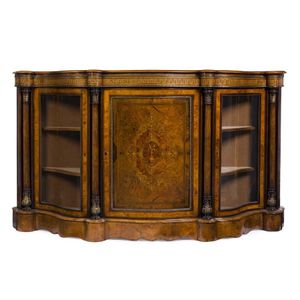French Walnut Bed with Burr Timber Panels
You must be a subscriber, and be logged in to view price and dealer details.
Subscribe Now to view actual auction price for this item
When you subscribe, you have the option of setting the currency in which to display prices to $Au, $US, $NZ or Stg.
- Foliate - Decorated with leaves or leaf-like forms.
- Burr - Burr (or in the USA, burl) is the timber from the knotted roots or deformed branch of the tree, which when cut, displays the small circular knots in various gradations of colour. It is always cut into a decorative veneer, most commonly seen as burr walnut on 19th century furniture.
- Panels - Timber pieces, usually of well-figured wood either recessed or applied over the frames of doors and as decoration elsewhere in the carcase of cabinet furniture. The panels may take a variety of shapes rectangular, square, shield shape, oval, half-round or in the form of Egyptian pylons.
- Art Deco Period - The Art Deco period was a cultural movement that emerged in the 1920s and 1930s, and was characterized by its emphasis on modernism, luxury, and elegance. The name "Art Deco" comes from the Exposition Internationale des Arts Décoratifs et Industriels Modernes, a large exhibition held in Paris in 1925 that showcased the latest trends in decorative arts.
Art Deco was a reaction against the ornate and elaborate styles of the previous era, and reflected a new modern sensibility. It was characterized by streamlined, geometric shapes, bright colours, and the use of new materials such as chrome, glass, and Bakelite. Art Deco designers sought to create a sense of luxury and sophistication, often incorporating expensive materials such as ivory, marble, and rare woods.
Art Deco had a significant impact on a wide range of artistic fields, including architecture, fashion, graphic design, and interior design. Some of the most iconic examples of Art Deco architecture include the Empire State Building in New York City, the Hoover Building in London, and the Palais de Chaillot in Paris.
The Art Deco period came to an end in the 1940s, as World War II and changing cultural trends led to a shift in artistic styles. However, Art Deco remains an important influence on design and art, and continues to be celebrated for its modernist sensibility and glamorous aesthetic.
This item has been included into following indexes:
- beds, material
- beds, period or style
Visually similar items

A late Victorian burr walnut, ebonised and gilt-metal mounted credenza with Wedgwood plaques the frieze applied with classical Wedgwood plaques, the central panelled door with oval Wedgwood plaque depicting a classical lady flanked by gilded rams masks and

A walnut serpentine credenza, English 19th century, with ormolu mounts and central marquetry panel, 105 cm high, 180 cm wide, 46 cm deep

Victorian free standing salon bookcase. Single door flanked by half columns, inlaid burr walnut with ormolu trim. Minor losses to ormolu and veneer. Good condition

A fine Empire style Karelian birch and walnut bed, early 20th century. the gently arched bed in contrasting dark and warm colours with fine stringing throughout, an ebonised panel to the headboard inlaid with allegorical figures in a chariot, with gilt bro
